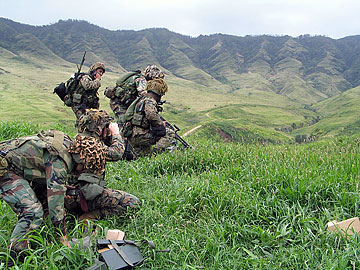IN THE MILITARY

STAR-BULLETIN / 2004
More than 50 Kaneohe Marines, members of India Company, 3rd Battalion, 3rd Marine Regiment, return to Makua Valley for a live-fire exercise. The last time the military used live ammunition in the valley was August 2004. CLICK FOR LARGE
|
|
Army makes public Makua Valley studies
Marine resource and archaeological reports both find little impact
As the Army presses its case for live-fire training in Makua Valley, it is offering two new surveys of the area for public review and comment.
A subsurface archaeological survey of the Leeward Oahu valley and a marine resources study of the area are available at several Oahu libraries. The public can comment on the Army documents at a public meeting Feb. 24 at 12:30 p.m. at the Waianae District Park.
WHERE TO VIEW THE SURVEYS
Copies of the Marine Resources Study Field Sampling Results and Risk Assessment ("Marine Resources Study") and the Archaeological Subsurface Survey within the Company Combined Arms Assault Course are available at: Waianae Public Library, 85-625 Farrington Highway; Wahiawa Public Library, 820 California Ave; Hawaii State Library, 478 S. King St.; and Pearl City Public Library, 1138 Waimano Home Road. A public meeting will be held at 12:30 p.m. Feb. 24 at the Waianae District Park at 85-601 Farrington Highway.
|
The archaeological survey was done to satisfy the terms of a 2001 federal court settlement agreement between the Army and Malama Makua which has been trying to halt use of valley by the Army. The Army was supposed to complete an environmental impact study justifying the continued use of the valley, which some Hawaiians considered sacred, in 2004.
David Henkin, who represents Malama Makua, said last week his experts are still reviewing the findings of the two studies.
The Army's archaeological study only found two areas of possible historical or cultural significance. Although bones were found in one area, the field crew doing the excavation determined the remains were mostly likely pig and the bones were reburied, the report said.
The report said a total of 550 "shovel probes" were attempted. "Most were sterile, with no conclusive cultural deposit found," the Army said in a Jan. 3 memo that was included in the report.
Terra Tech conducted the marine resources study to determine whether the Army's use of the valley caused any possible health hazards at Makua Beach and Makua muliwai. A muliwai is defined as a stream mouth isolated from the sea.
Fifteen fish samples were collected from two muliwai -- also described as small ponds -- near Makua Military Reservation. In addition, 11 fish samples and four limu samples were collected from the beach fronting the training area.
Fish samples from Makua did not differ from results from Sandy Beach, the report said.
The samples were tested for explosives, metals, pesticides and dioxins.
The report also questioned the importance of the muliwai in the area as the only source of food for people living there.
"It is unlikely that the two muliwai evaluated here could hold enough fish to support even one subsistence fisherman, let alone a population of subsistence fishermen," the report said. "The assumption of a subsistence fisherman relying exclusively on the muliwai is unrealistic and, therefore, the risk estimate likely overestimates exposures to chemicals in the fish."
The Army's cultural survey was done on three occasions from November to December.
In 1998, Malama Makua sued the Army, arguing federal environmental law required the Army to complete an environmental study before it could continue to use the valley for live-fire training.
Under a federal court agreement, the Army was forced to stop firing live ammunition in the valley in 2001 until it completed an environmental impact study in 2004. The Army now says that study will be done this year. The last time the military used live ammunition in the valley was August 2004.
Army studies have found that there were more than 100 Hawaiian cultural sites in the valley. Some native Hawaiians consider the valley sacred, and it is also the home to more than 30 endangered plants and four animals -- the kahuli tree snail, elepaio, Hawaiian hoary bat, and pueo or Hawaiian owl.
Lt. Gen. John Brown, who commands all Army troops in the Pacific and Asia, is working on a report on what the loss of the 4,190-acre Makua training range would mean to troops in the Pacific. It has been a live-fire range since World War II.
Brown said his report will outline "what other training capabilities would have to be provided inside Hawaii to allow us not to use Makua for live-fire training."

